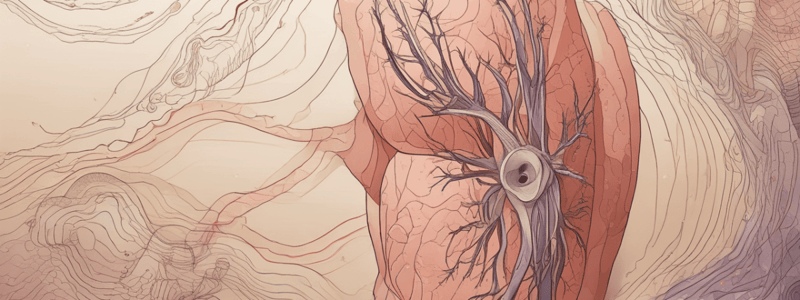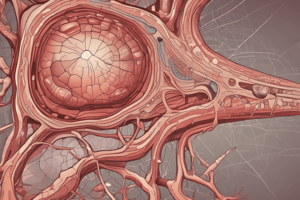Podcast
Questions and Answers
Which type of connective tissue is found in the papillary region of the dermis?
Which type of connective tissue is found in the papillary region of the dermis?
- Loose CT with few fibers
- Dense irregular CT
- Dense regular CT with collagen fibers
- Areolar CT with elastic fibers (correct)
What is the primary function of sebaceous glands?
What is the primary function of sebaceous glands?
- To produce sweat for thermoregulation
- To detect touch and pressure
- To secrete sebum that coats hairs and holds moisture in the skin (correct)
- To synthesize vitamin D
What is the main function of eccrine sweat glands?
What is the main function of eccrine sweat glands?
- To secrete sweat for thermoregulation and excretion (correct)
- To detect pain and pressure
- To synthesize vitamin D
- To produce sebum for hair growth
Which layer of the skin attaches the dermis to underlying structures?
Which layer of the skin attaches the dermis to underlying structures?
What is the function of arrector pili muscles?
What is the function of arrector pili muscles?
What is the function of the reticular region of the dermis?
What is the function of the reticular region of the dermis?
What is the function of the integumentary system in vitamin D synthesis?
What is the function of the integumentary system in vitamin D synthesis?
What is the function of the nails?
What is the function of the nails?
What is the primary function of keratinocytes in the epidermis?
What is the primary function of keratinocytes in the epidermis?
Which layer of the epidermis is also known as stratum germinativum?
Which layer of the epidermis is also known as stratum germinativum?
What unique characteristic defines the stratum lucidum?
What unique characteristic defines the stratum lucidum?
What role do dendritic cells play in the epidermis?
What role do dendritic cells play in the epidermis?
The main function of melanocytes is to produce which pigment?
The main function of melanocytes is to produce which pigment?
What does the stratum granulosum primarily consist of?
What does the stratum granulosum primarily consist of?
What important barrier is formed by lamellar granules in the epidermis?
What important barrier is formed by lamellar granules in the epidermis?
How thick can the epidermis range in humans?
How thick can the epidermis range in humans?
Flashcards are hidden until you start studying
Study Notes
Epidermis
- Keratinized stratified squamous epithelium
- Composed of:
- Keratinocytes (90%): produce fibrous protein keratin, provide protective properties of skin
- Melanocytes (8%): produce melanin, protect from UV light
- Dendritic cells: involved in immune response, produced in red bone marrow
- Tactile epithelial cells: associated with nerve endings, important in sense of touch
- Thickness: 0.1 mm – 2 mm
- Layers of epidermis (strata, from deep → superficial):
- Stratum basale: one row of mainly cuboidal or columnar keratinocytes, melanocytes and tactile cells scattered among keratinocytes
- Stratum spinosum: 8-10 cells thick, more superficial keratinocytes are flatter
- Stratum granulosum: 3-5 cells thick, flattened keratinocytes, nuclei and organelles degenerate, lots of keratin
- Stratum lucidum: only in thicker skin, 3-5 cells thick, very flat, dead keratinocytes
- Stratum corneum: 25-30 cells thick, very flat, dead keratinocytes, waterproof barrier that protects from light, heat, chemicals and invaders
Dermis
- Connective tissue with embedded structures
- Cells include: fibroblasts, macrophages
- Contains: blood vessels, nerves, glands and hair follicles
- Regions of dermis:
- Papillary region: areolar CT with elastic fibers, projects into epidermis as dermal papillae, loops of capillaries, touch receptors
- Reticular region: dense irregular CT with lots of collagen and some elastin, contains bits of adipose, hair follicles, nerves, oil and sweat glands
Hypodermis
- Attaches dermis to underlying structures
- Composed of: areolar and adipose tissue
- Also known as subcutaneous layer or superficial fascia
- Contains: blood vessels and nerves
Functions of Integumentary System
- Temperature regulation: evaporation of sweat decreases body temperature, changes in blood flow
- Protection: physical barrier to invasion, dehydration and UV radiation, contains cells of immune system
- Sensation: nerve cells with receptors for pain, touch, pressure, temperature
- Excretion: water and dissolved substances in sweat
- Acts as a blood reservoir: flow can be shifted to hard-working muscles if needed
- Vitamin D synthesis: epidermis makes inactive form of vitamin D upon exposure to UV
Derivatives of the Epidermis (skin appendages)
- Hair:
- Dead, keratinized cells
- Shaft projects from surface of skin
- Root is beneath skin surface, surrounded by hair follicle
- Functions: protect from light, decrease heat loss, protect eyes and nose from particles, sense of touch, hold chemical signals
- Sebaceous (oil) glands:
- Holocrine glands
- Ducts usually open to hair follicle
- Secrete sebum (mix of fats, cholesterol, proteins, salts, pheromones) that coats hairs, holds moisture in skin, and inhibits bacterial growth
- Sudoriferous (sweat) glands:
- Eccrine sweat glands:
- On most skin
- Ducts open to skin surface
- Secrete sweat (water, salt, some wastes) for cooling body, excretion, and acidity protects from bacteria
- Apocrine sweat glands:
- In axillary, genital and anal regions
- Ducts open to hair follicles
- Secrete sweat, fats and proteins, may function in sexual signaling
- Eccrine sweat glands:
- Nails:
- Hard, keratinized cells
- Nail body is visible
- Root is under skin
- Functions: grasp and manipulate objects, scratching
Studying That Suits You
Use AI to generate personalized quizzes and flashcards to suit your learning preferences.




